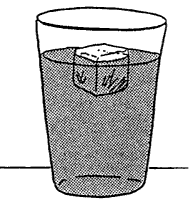Whiskey on the rock
 It is a well known fact that melting of an ice cube floating on pure water does not change the water level. Then what will happen if an ice cube floats on a liquid that is not pure water? Consider the following situation:
It is a well known fact that melting of an ice cube floating on pure water does not change the water level. Then what will happen if an ice cube floats on a liquid that is not pure water? Consider the following situation:
Johnny ordered a whiskey-on-the-rock. A large ice ball is freely floating on his whiskey. Determine what happens to the surface level of his whiskey when the ice ball melts completely.
Details and Assumptions
- There is enough whiskey for the ice to float freely (unlike the image).
- The density of pure water (as a liquid) is 1.00 g/ml.
- The density of the ice ball is 0.90 g/ml.
- The density of Johnny's whiskey is 0.95 g/ml.
- Johnny does not drink his whiskey before the ice ball completely melts.
- Ignore any evaporation.
P.S. There is more beyond the calculation, but the answer is indisputable!
This section requires Javascript.
You are seeing this because something didn't load right. We suggest you, (a) try
refreshing the page, (b) enabling javascript if it is disabled on your browser and,
finally, (c)
loading the
non-javascript version of this page
. We're sorry about the hassle.
Well, I am glad to say that we only need the help of just one person to make sense of what is happening here: Archimedes To start off, let's establish the simple basics of why does the ice cube even floats. According to Archimedes' Principle, the upthrust exerted on the submerged (partial or fully) object by the fluid is equal to the weight of the fluid displaced. And of course, the origin underlying this principle is that due to the pressure difference between the top and bottom sides of the submerged object; with the top face experiencing less hydro-static pressure than that for the bottom surface using
P
=
h
ρ
g
. In essence, this would mean that focusing in particular to a
floating object
case, the Archimedes Principle can be extended to explain the Principle of Flotation which now reads,"the weight of the floating object is equal to the weight of the fluid displaced." With this in mind, we can start delving into the mathematics.
For an ice cube of mass,
M
volume,
V
i
c
e
and density,
ρ
i
c
e
, the volume of the ice can be expressed as:
V
i
c
e
=
ρ
i
c
e
M
. Next, we consider the fluid that the ice is floating on. For the whiskey of density,
ρ
w
h
i
s
k
e
y
, we can then apply the Principle of Flotation, to obtain this relation:
M
g
=
ρ
w
h
i
s
k
e
y
V
d
i
s
p
l
a
c
e
d
g
, which gives the volume displaced to be,
V
d
i
s
p
l
a
c
e
d
=
ρ
w
h
i
s
k
e
y
M
.
Note that for a floating object,
V
d
i
s
p
l
a
c
e
d
=
V
s
u
b
m
e
r
g
e
d
. And now, we shall consider the final piece of the puzzle: the melted ice cube. When it melts, the mass of the melted ice must be the same as before the process of melting. Hence, the mass,
M
remains constant but now the volume of the melted ice shall be taken as
ρ
w
a
t
e
r
and density to be
ρ
w
a
t
e
r
.
To start off, let's establish the simple basics of why does the ice cube even floats. According to Archimedes' Principle, the upthrust exerted on the submerged (partial or fully) object by the fluid is equal to the weight of the fluid displaced. And of course, the origin underlying this principle is that due to the pressure difference between the top and bottom sides of the submerged object; with the top face experiencing less hydro-static pressure than that for the bottom surface using
P
=
h
ρ
g
. In essence, this would mean that focusing in particular to a
floating object
case, the Archimedes Principle can be extended to explain the Principle of Flotation which now reads,"the weight of the floating object is equal to the weight of the fluid displaced." With this in mind, we can start delving into the mathematics.
For an ice cube of mass,
M
volume,
V
i
c
e
and density,
ρ
i
c
e
, the volume of the ice can be expressed as:
V
i
c
e
=
ρ
i
c
e
M
. Next, we consider the fluid that the ice is floating on. For the whiskey of density,
ρ
w
h
i
s
k
e
y
, we can then apply the Principle of Flotation, to obtain this relation:
M
g
=
ρ
w
h
i
s
k
e
y
V
d
i
s
p
l
a
c
e
d
g
, which gives the volume displaced to be,
V
d
i
s
p
l
a
c
e
d
=
ρ
w
h
i
s
k
e
y
M
.
Note that for a floating object,
V
d
i
s
p
l
a
c
e
d
=
V
s
u
b
m
e
r
g
e
d
. And now, we shall consider the final piece of the puzzle: the melted ice cube. When it melts, the mass of the melted ice must be the same as before the process of melting. Hence, the mass,
M
remains constant but now the volume of the melted ice shall be taken as
ρ
w
a
t
e
r
and density to be
ρ
w
a
t
e
r
.
Now, because the floating ice melts, we need to observe the following comparison carefully. If we make use of the above scenario's stated well known fact that melting of an ice cube floating on pure water does not change the water level, we would realize that the reason for such has something to do with the relationship between the volume displaced and finally, the volume of the melted ice. Think about it, if the volume displaced is equal to the volume of the ice, no confusion, the water level is the same, V d i s p l a c e d = V i c e . But what if, V d i s p l a c e d > V i c e or V d i s p l a c e d < V i c e ? But let us hold our horses, and identify which is the case for our whiskey. Now, knowing that
ρ w h i s k e y < ρ w a t e r , ρ w h i s k e y 1 > ρ w a t e r 1 , ρ w h i s k e y M > ρ w a t e r M , V d i s p l a c e d > V m e l t e d i c e . And what could we conclude here? Since the volume displaced is more than the actual volume of water that is finally added to the whiskey drink, we realise that there is a net decrease in volume of the whiskey drink and hence, the water level falls. Well, there you go, I will leave it to you to think about V d i s p l a c e d < V i c e . Happy drinking.